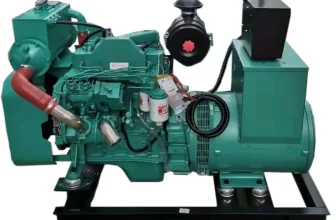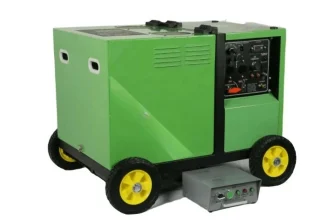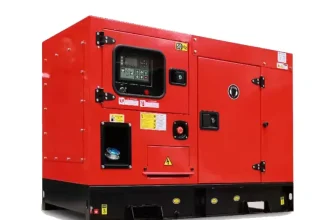Proper positioning of a generator is an often overlooked aspect of safe generator usage, yet it carries paramount importance. Generators, used as alternative power sources during power outages, can pose potential safety risks if not placed strategically. They can emit harmful exhaust gases, cause fires if overheated, and create unfriendly noise levels. Therefore, when we talk about safety, carbon monoxide hazards, fire risks, noise pollution, and ensuring adequate ventilation, the location of your generator becomes a vital factor. This article will discuss the recommended distance a generator should be from your house and the various factors that influence this decision, making it easier for you to enjoy the advantages of a generator while minimizing potential risks.
Understanding Generators
Brief overview of what is a generator and how it works
A generator, in the most basic terms, is a machine that converts mechanical energy into electrical energy. This energy-making mechanism is employed worldwide to back up power suspensions during outages, or deliver electricity in regions where other means of power generation are unattainable.
The core operation of a generator is based on the principles of electromagnetic induction, a theory propagated by scientist Michael Faraday. He noted that the movement of an electric conductor, like a wire, in a magnetic field, could generate electric current in the conductor. Following this principle, a generator operates by utilizing a fuel source to run a motor attached to an alternator. The motor rotates a magnet around a set of conductive coils, which creates a constant flow of electrons- this is basically your electricity. Fuel sources for generators can vary from diesel, gas, propane, or even solar energy, further amplifying the versatility and the significance of generators.
Different types of generators
Stationary generators
Stationary, or standby generators, are designed for permanent installation at a specific location. These generators are larger and more powerful than portable alternatives, and they’re typically designed to automatically start when they detect a power outage. This reliability is one of the most appealing aspects of a stationary generator.
Stationary generators are often suitable for both residential and commercial applications. For residential applications, they are commonly used to power essential home systems such as refrigeration, heating or cooling, and lighting during blackouts. For businesses, they ensure continuity of operations and prevent downtime during power interruptions.
These generators run on a variety of fuel types, including propane, natural gas or diesel, and they’re connected directly to the home or business’s electrical system to supply power when necessary. They require a professional installation to ensure they are correctly and safely connected. Because of their size and permanence, stationary generators often require a significant initial investment but provide heavy-duty and long-term solutions for power needs.
In terms of maintenance, stationary generators typically require regular inspection and servicing, just like any other major appliance. However, thanks to their built-in self-diagnostic system, it’s easier to anticipate and mitigate any potential issues before they escalate into full-blown problems.
Stationary generators are a great investment for anyone who lives in an area with frequent power outages or who needs to ensure continuous power supply for a business. Their reliability, convenience, and power output often outweigh their initial cost.
Portable generators
Portable generators, as the name implies, can be transported and used anywhere there’s a need for electricity. They are commonly compact, making them excellent sources of backup power supply for outdoor events, camping, or small homes. You can also use portable generators to power individual appliances during a power outage.
These generators work by using an internal combustion engine that runs on fuel, typically gasoline, propane, or diesel. The engine operates an electrical generator, which provides power. You can connect devices directly to the generator or plug them into an installed electrical outlet.
One main feature of portable generators is their varied power output. Depending on the model, some can provide power as low as 3,000 watts, while others can ramp up to 10,000 watts. Therefore, it’s crucial to assess your power needs to choose the correct model for you.
Despite their versatility, portable generators do have some limitations. They typically run for several hours, not days, and will need refueling. Moreover, due to potential carbon monoxide emissions, extreme care must be exercised to place them far from indoor living spaces, including garages or sheds. It’s also important to remember that portable generators should not be exposed to direct outdoor elements, like rain or extreme heat.
Safety Considerations for Generator Placement
Explanation of potential risks associated
Carbon Monoxide Poisoning
Carbon monoxide poisoning is a significant risk when it comes to improper generator placement. This hazardous gas is odorless, colorless, and tasteless, making it near impossible to detect without a carbon monoxide detector. As a byproduct of fuel combustion, generators produce carbon monoxide when in use. The danger lies in its capacity to build up to lethal levels in enclosed or even partially enclosed spaces.
In humans, carbon monoxide is readily absorbed through the lungs, binding to hemoglobin (the oxygen-carrying compound in blood) and preventing it from delivering vital oxygen around the body. The resulting symptoms, resembling flu-like illnesses, include dizziness, headaches, nausea, breathlessness, collapse, and even loss of consciousness or death in severe cases.
According to the Centers for Disease Control and Prevention (CDC), more than 400 Americans die each year from unintentional carbon monoxide poisoning not linked to fires, and generator use is a significant contributor to this figure.
Therefore, it is crucial that a generator is never used inside homes, garages, crawl spaces, or other enclosed or partially enclosed areas, even with ventilation. Always place the generator outside, far away from windows, doors, and vent openings to lower the risk of carbon monoxide poisoning.
Fire Hazards
Generators, while incredibly useful during power outages, can also pose significant fire hazards if not properly installed and maintained. They generate heat while they operate, and any nearby flammable materials can easily catch fire if placed too close to the generator. Gasoline and other fuels used to run generators are also highly flammable and can easily ignite if not stored and handled properly. Feeding a running generator with fuel could lead to spillage, creating a path for a fire to reach the fuel container.
In addition, generators produce electricity, and any faulty wiring or connection can lead to a short circuit, sparking a fire. This problem is often exacerbated when people attempt DIY generator installations without understanding electrical safety protocols well.
Many generator fires also stem from insufficient maintenance. Not cleaning the generator and allowing dirt, oil, or debris accumulation can lead to overheating and eventually, a fire. Keeping a clean and well-maintained generator can significantly reduce this risk.
In essence, it is not the generator itself but the incorrect or unsafe use that poses a fire hazard. Therefore, it is an integral part of owning a generator to understand these risks and take steps to mitigate them.
Importance of following safety guidelines
Adherence to safety guidelines when placing a generator is not only recommended, it’s vital. Ignoring these precautionary measures can have serious implications and may put you and your family at risk.
The first and perhaps most immediate issue is the risk of carbon monoxide (CO) poisoning. Generators can produce high levels of this deadly gas, which is colorless, odorless, and tasteless. Even just a few minutes of exposure can lead to harmful effects, with prolonged exposure leading to fatalities.
Then there’s the risk of fire. An improperly placed generator can cause heat or sparks that ignite combustible materials nearby. This is a significant fire hazard, especially if the generator is operating near flammable materials or in an area with poor ventilation.
Furthermore, a generator’s noise and vibration levels can be a concern. Not only can a poorly placed generator disrupt your peace and quiet, but it can also cause structural damage over time if placed too close to your property’s walls.
Lastly, there’s the issue of electrical safety to consider. Using a generator incorrectly can lead to electrocution or electric shock injuries. Additionally, incorrect use can result in power surges that can damage your appliances and electronics.
Thus, understanding and complying with safety guidelines for generator placement isn’t just good practice. It’s a necessity. It’s about reducing these risks and ensuring your generator operates efficiently and safely. Remember, generators are immensely useful tools – but only when used correctly.
Recommended Distance for Generator Placement
National Fire Protection Association guidelines
The National Fire Protection Association (NFPA) provides clear guidelines for generator placement, specifically for stationary or standby generator systems. As part of these guidelines, they recommend that these generators be placed at least 5 feet away from any openings to the house, such as doors, windows, or vents.
Additionally, the NFPA advises that one should consider the prevailing wind directions in the area. This is because the wind can help in dispersing the exhaust gases, thereby reducing the risk of these gases drifting back into the house.
The generator should further be located at least 5 feet away from any combustible walls and should never be placed directly underneath an overhang, such as a balcony or deck. Ensuring proper clearance between the generator and any combustible surfaces minimizes the chance for heat produced by the generator to ignite the material and cause a fire.
It’s also crucial to remember that the NFPA’s recommended guidelines are not to be seen as replacement for any specific manufacturer’s instructions. Instead, they should be used in conjunction with these instructions to ensure you place your generator in the safest location possible.
Manufacturer’s guidelines
Often, the ideal distance a generator should be placed from a house is specified in the manufacturer’s manual that accompanies the generator upon purchase. These guidelines can vary from one manufacturer to another, but on average, they suggest a clearance of at least 5 feet from any openings to the home including doors, windows, and vents. Additionally, a minimum distance of 5 feet must be observed from any flammable materials. In some cases, larger generators may require a bigger buffer zone and this information will be explicitly mentioned in the manual.
It is strongly recommended to adhere strictly to these guidelines not just for safety reasons, but also for the sake of valid warranties. Non-compliance with the manufacturer’s guidelines could void the warranty, leaving the owner without any coverage for damages. Following these instructions also ensures maximum efficiency and longevity of the power equipment.
A key point to remember is that manufacturer’s guidelines should not be at odds with the National Fire Protection Association guidelines. If there is any discrepancy between the two, it is always safer to follow the stricter standards.
Importance of airflow and ventilation
Proper airflow and ventilation are crucial components when it comes to determining the distance between your generator and your house. Generators, especially when they are operating at full capacity, can generate a considerable amount of heat. Therefore, placing a generator too close to structures, including your home, can potentially pose a risk of overheating, which could result in an array of problems, including generator malfunction or even a fire outbreak in severe cases.
Airflow is necessary for the cooling system of the generator to function effectively and prevent overheating. It ensures unobstructed passage of cool air into the generator and warm air out of it. Thus, sufficient space is required around the generator for the free flow of air.
Ventilation is equally crucial to prevent the build-up of harmful exhaust gases, notably carbon monoxide, that generators produce when they’re running. Without proper ventilation, these harmful gases can accumulate and cause serious health hazards. If a generator is too close to a house with doors or windows open, these gases can potentially leak into the home, risking the lives of those inside.
In essence, a careful balance needs to be struck when locating your generator. The placement should be such that it encourages proper airflow and ventilation, preventing overheating and the build-up of hazardous exhaust gases, while facilitating the efficient operation of the generator. This is one of the reasons why professional advice is often sought when determining where to install your generator.
Other Factors affecting the Placement of Generators
Noise considerations
While safety should always be the priority when placing a generator, noise considerations can significantly impact its positioning. Generators can be quite noisy during operation, and this noise can be bothersome for both the occupants of the house and the surrounding neighbors. Therefore, placing the generator too close to the house can disrupt sleep and day-to-day activities.
The level of noise produced by generators varies significantly depending on size, model, and whether it’s running at full or reduced power. It’s important to review the generator’s specifications to understand the expected noise level. Also, remember that noises tend to get amplified at night, so what might seem tolerable during the day could become an issue at nighttime.
When considering generator placement, you should try locating it as far from bedrooms and living areas as possible. Enclosing the generator with sound barriers or generator boxes can help dampen the noise. However, this strategy requires careful planning to ensure adequate ventilation. You might also consider purchasing a generator with a noise reduction feature, or investing in a generator silencer or muffler.
In conclusion, while it is not the most pressing issue, noise consideration is an important factor in generator placement. Thus, it’s important to select an ideal location where its operation won’t cause disturbance or discomfort.
Accessibility and security
While considering the placement of generators, accessibility and security are two factors that cannot be overlooked. These vital components directly influence the operation and longevity of the generator.
Starting with accessibility, it is crucial to place a generator where it can be easily accessed for maintenance and repairs. Regular checks are necessary to ensure the generator functions correctly when the need arises. Therefore, the chosen site should not be too secluded or blocked off by other structures, objects, or greenery that can hamper regular maintenance routines or impede immediate accessibility in an emergency situation.
Security, on the other hand, encompasses both physical and operational safety. From the physical perspective, the generator should be positioned in an area that prevents unauthorized access or tampering. This can be achieved by enclosing the generator in a secure, locked structure or installing surveillance cameras. Moreover, the secure placement deters theft, particularly for portable generators which are easier to move.
Operationally, placement decisions should be guided by a wish to avoid excessive wear on the generator and extension cords. Placing the generator too far from the house may require the use of longer extension cords, which can contribute to power loss. Conversely, having it too close can risk damage to the house structure or wiring. The delicate balance of these factors underscores the need for professional advice on secure and accessible generator placement.
Ultimately, the choice of generator location should keep both accessibility for maintenance and the security for prevention of unauthorized use in mind, to ensure the smooth operation and longevity of the generator.
Impact of weather conditions
Heat and Sunlight
The impact of weather conditions, specifically heat and sunlight, plays a significant role in the placement of your generator. Sunlight can adversely affect some components of your generator, particularly if it’s a plastic body unit. Prolonged exposure to direct sunlight can cause these materials to degrade faster, leading to potential damage and affecting the longevity of your generator.
The issue of heat is another considerable factor. In the summer months or in warmer climates, excessive heat can cause your generator to overheat, especially if it’s running for an extended period. Overheating can lower the efficiency of your generator and even cause damage to internal components, resulting in costly repairs or even replacement. Therefore, it’s essential to place your generator in a location where it will be somewhat shielded from the more intense heat of the day to maintain its performance and durability.
Just remember, any shelter or protection shouldn’t compromise ventilation. Proper cooling and airflow are essential for the generator’s operation, so while you aim to shield it from direct sunlight or harsh heat, ensure that this doesn’t impede air movement around the unit.
Understanding the interplay of heat and sunlight and making suitable accommodation for these conditions should be a part of your planning when situating your generator for optimal use and long life.
Rain and snow
Exposure to rain and snow can have a detrimental impact on your generator. Water can cause significant damage to the engine and electrical components. Using a generator in wet conditions can also increase risk of electrocution. Therefore, it is crucial to always shield your generator from the elements.
Snow can pose a risk as well, especially if the generator is not sufficiently elevated from the ground. The snow can clog the exhaust and cause carbon monoxide to accumulate, which is a deadly threat. Also, snow can melt and get into the electrical parts of the generator, causing crucial dysfunction or damage.
In both cases, housing your generator in a well-ventilated enclosure or investing in a generator designed for outdoor use with weather-resistant features can be beneficial. It is also vital to ensure the generator is always on a dry surface when operating to minimize risk of electrocution. Always remember to never touch the generator with wet hands or while standing in water.
In any case, the safety precautions outlined by the manufacturer should be closely followed to ensure optimal performance and safety, regardless of the weather conditions.
How to Install Generators Properly
Basics of installation process
The installation process for a generator varies based on the type, portable or stationary, and can be fairly complex. However, here are some basic steps that are generally involved in this process.
The very first step is choosing the right location. This should be a place where the generator can be safely operated, ideally at least 20 feet away from the house to prevent any fire hazards or carbon monoxide poisoning incidents. It should also be easily accessible for maintenance and refueling and should have a protective covering if possible, to protect from inclement weather conditions.
Once the ideal location is determined, the installation begins with preparing a base for your generator. This often involves laying a concrete slab for the generator to rest on. This base not only provides a steady platform but it also helps to reduce the noise and vibration created by the generator.
Next, comes the electrical wiring, which should be executed by a licensed electrician. This involves connecting the generator to a transfer switch, which is then connected to the home’s electrical panel. The transfer switch is crucial as it safely switches the power source of your house from the electrical grid to the generator in case of a power outage.
The fuel source must also be established. For portable generators, this might be as simple as having fresh gasoline on hand. However, for home standby generators, a larger and constant fuel source (such as a large propane tank or natural gas line) is needed. This also often requires the assistance of professionals.
Lastly, once all the physical connections have been taken care of, the generator should be tested to make sure it’s operating properly. This should involve starting the generator and letting it run for a while to ensure it operates cleanly and efficiently, without any glitches.
Indeed, installing a generator is not a task to be taken lightly. It involves dealing with dangerous substances, heavy objects, and complex wiring systems. Hence, it is recommended to have professionals handle this task to ensure the safety and efficiency of your generator.
Importance of hiring professionals for installation
Hiring professionals for generator installation is essential for several reasons. First, professionals have the necessary knowledge and experience to adequately assess suitable generator placement. As we’ve noted, this involves choosing a location that takes into account safety regulations, environmental factors, and practicality.
A professionally installed generator can also ensure it operates as efficiently as possible, optimizing your power supply and prolonging the lifespan of the unit. Incorrect installation could lead to overheating or disruptions in power, and at worst, can be a significant risk to your home and safety.
Moreover, professionals are well-versed in local codes and regulations regarding generator installation. This is crucial because improper placement could potentially violate regulations leading to hefty fines or put you in violation of your homeowner’s insurance policy.
By entrusting a professional with the task, you can also save yourself the extensive time and stress that a DIY installation would involve. It is a task that requires specialized knowledge and expertise to perform correctly and safely, hence it is not advisable for untrained individuals to attempt.
Importantly, having your generator installed by a professional often means that the work is guaranteed. If any problems arise post-installation, the professional or company will be responsible for addressing these issues.
Overall, hiring professionals for generator installation aids in enhancing safety, ensuring regulatory compliance, and maximizing the efficiency and performance of your unit.
Conclusion
Summary of key points
We cannot overstate the importance of the safe and strategic positioning of your generator. This creates a balance between utility, safety, and peace, ensuring an uninterrupted power supply without risking the health and safety of your household. Remember, carbon monoxide poisoning and fire hazards are real risks associated with improper generator placement. So, keeping it at a suitable distance from the house – typically following the National Fire Protection Association guidelines and manufacturer’s specifications – is crucial.
Ensure proper airflow and ventilation, factor in noise considerations, and don’t forget to account for accessibility, security, and weather conditions, such as heat, sunlight, rain, and snow. And while you may be a DIY enthusiast, remember that professional assistance can be invaluable when setting up your generator. In the end, how you place and install your generator can protect your home, your family, and potentially save lives.
The value of proper generator placement to the safety of the household.
A properly placed generator is more than a convenience – it’s a commitment to safety. It is critically important for every homeowner to consider the correct placement of their generator to prevent possible accidents or damage to the home. When placed correctly, according to guidelines offered by the National Fire Protection Association and the generator’s manufacturer, the risk of carbon monoxide poisoning and fire hazards can be significantly reduced. Aside from safety, correct installation and positioning also have practical benefits, such as noise reduction, easy accessibility, and protection from harsh weather conditions. Therefore, a well-placed generator ultimately contributes to the overall safety and well-being of your household.







